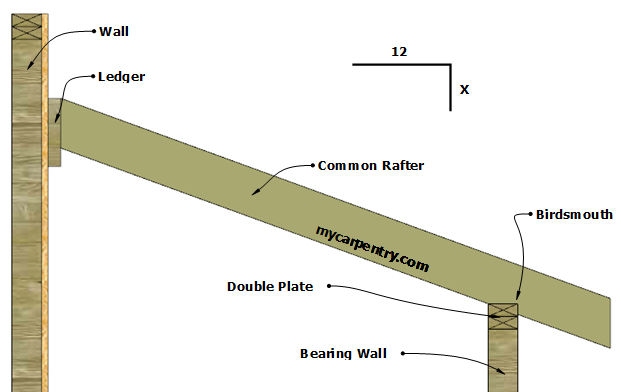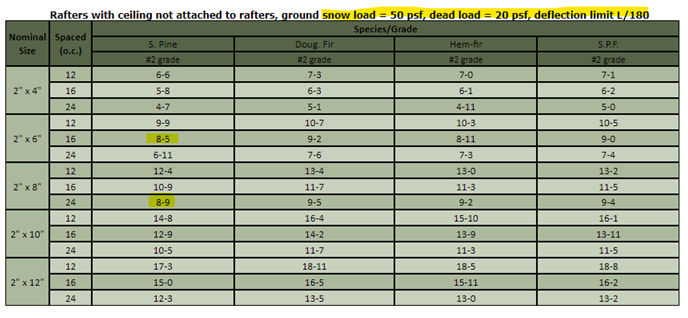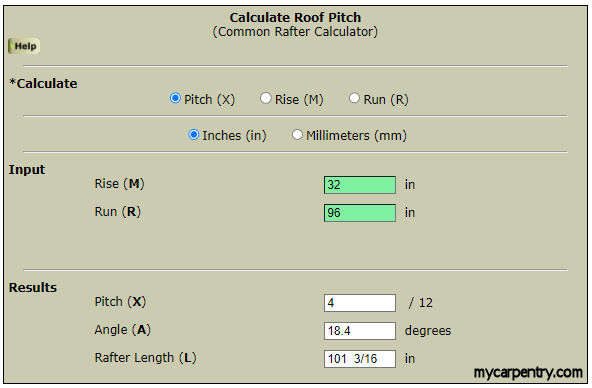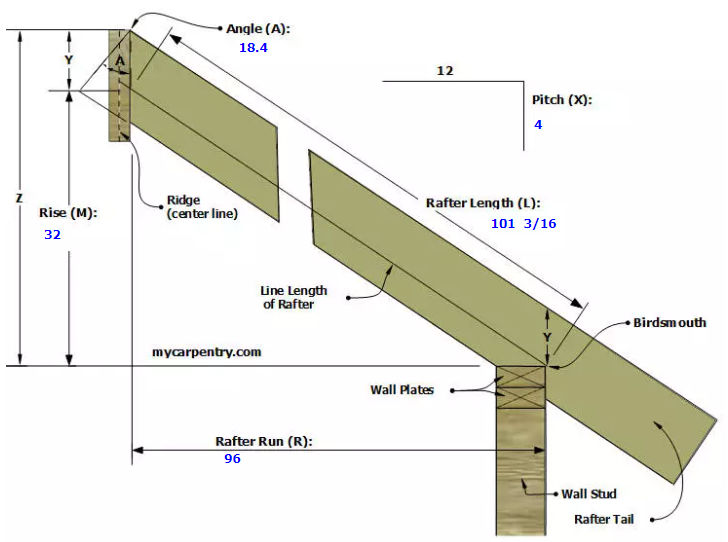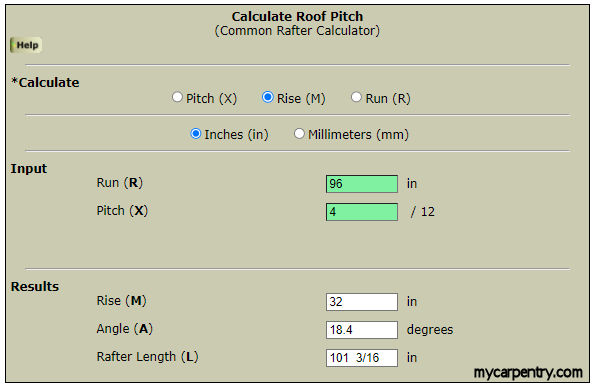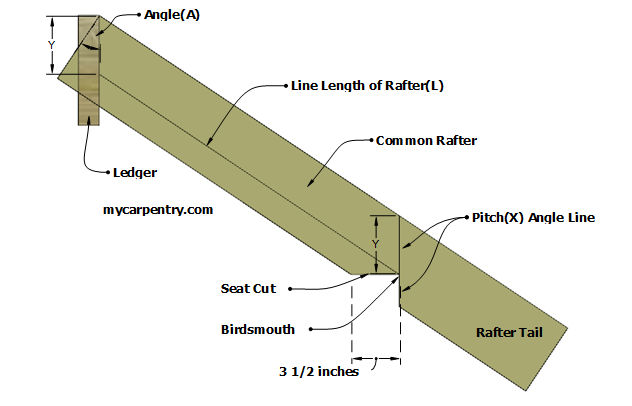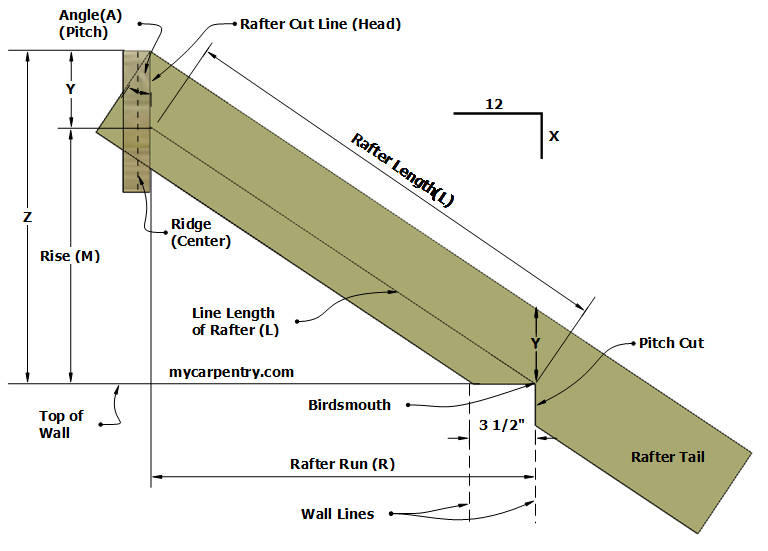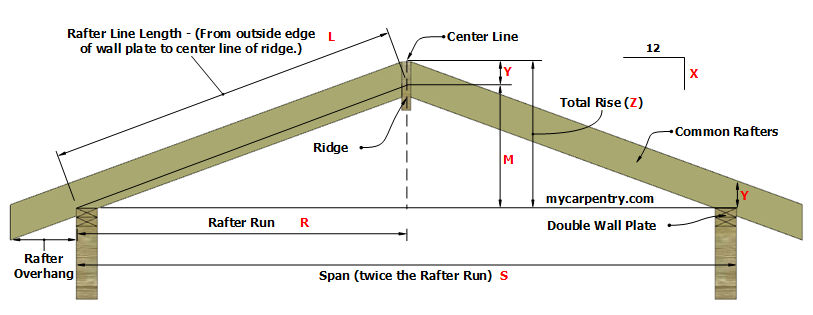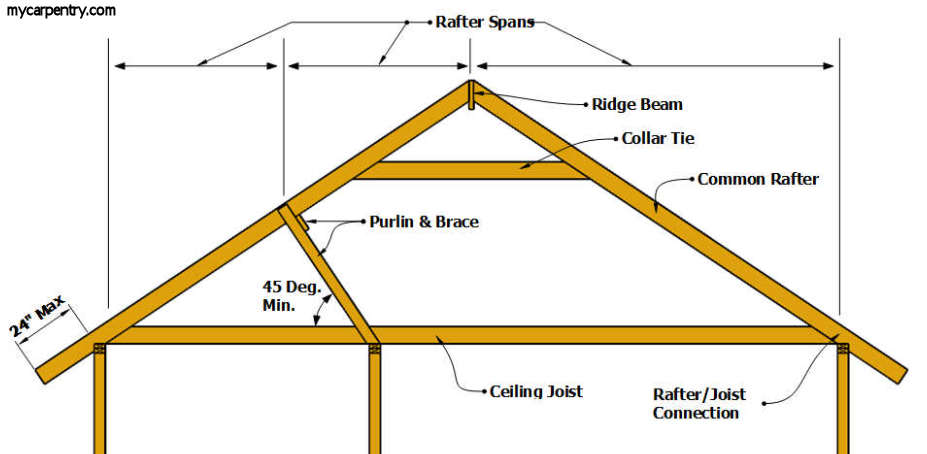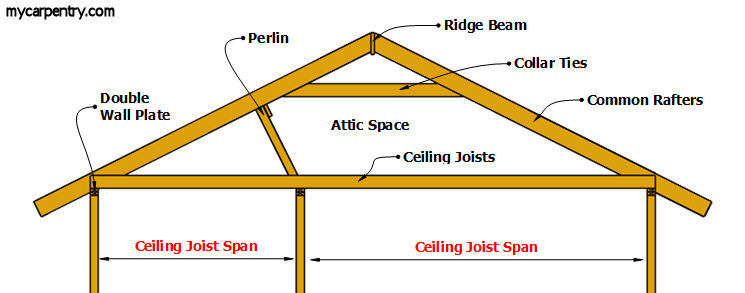Roof Framing
Framing Shed and Gable Roofs
The roof framing you do depends on the type of roof you want to build. The focus of this article is on framing shed and gable roofs.
On a typical shed roof, rafters attach on the upper end to a ledger fastened to a wall or other structure. Gable roofs typically have a supported ridge or ridge beam with the upper ends of rafters attached on both sides.
Framing a Shed Roof
A simple shed roof is the most basic roof design and is the perfect example for learning how to design and frame a roof.
When you are preparing to build a shed roof, you must first engineer the rafters - that is, know the species of wood you will use for the rafters, the nominal size of the rafters (2x6, 2x8, etc.), and the spacing of the rafters.
To determine the size of the rafters, using span tables, you need to know three things:
- Design Load: - This is the Dead Load (weight of the framing) + Live Load (wind, snow, etc.)
- Rafter Material: Select an available species of framing lumber in your area.
- Rafter Run: This is the horizontal distance between supports.
For this example, let's say you have the following design criteria:
- Design Load: 70 PSF (snow load of 50 PSF and a dead load of 20 PSF)
- Rafter Material: Southern Pine #2 Grade (because it is the most widely used framing lumber in my region)
- Rafter Run: 8 feet (horizontal distance between my Ledger and outer wall)
Using the Rafter Span Tables on mycarpentry.com, you can see that 2x6 rafters (Southern Pine #2 Grade), spaced 16 inches apart, will span 8-5 (8 feet - 5 inches).
You may have noticed that Southern Pine 2x8 rafters, spaced 24 inches apart, have a maximum span of 8-9 (8 feet - 9 inches). The rafter size and spacing you choose are up to you so long as they meet the minimum design requirements. For this example, we will use 2x6 rafters.
As a side note, I tend to over-design all of my structures. I think it is better to over-design than to under-design a roof structure.
To calculate maximum rafter spans of other common lumber species and grades, see the International Residential Code (IRC).
Roof Framing and Pitch
Roof pitch - sometimes called slope - is represented as X in 12. For example, a roof pitch that rises 6 inches for every 12 inches of run is said to have a six-twelve pitch.
Once the rafter size has been determined (2x6 in this example), the next step is to determine the Pitch(X) of your roof so that you can layout and cut the angles on your rafters.
How to Calculate Roof Pitch?
If you know the rafter Rise(M) and Run(R), you can calculate the Roof Pitch using the Roof Pitch Calculator on mycarpentry.com.
For example, Enter 32 inches for the rafter Rise and 96 inches (8 feet) in the Run field. The results will automatically be displayed.
Once you have determined the roof's Pitch(X) and Angle(A), you have the required information for laying out the rafters.
The diagram below shows the results of the Roof Pitch Calculator and how the results apply to the various elements of rafter layout.
Note: The Rafter Rise(M) refers to the height at the upper Line Length of the rafter, not the finished height of the Ledger itself.
How to Calculate Rafter Rise?
If you know the Rafter Run(R) and Roof Pitch(X) of your roof, you can calculate Rafter Rise(M) using the Roof Pitch Calculator on mycarpentry.com.
For example, open the calculator and, in the Calculate section, select Rise(M). The input fields on the calculator will change to Run(R) and Pitch(X). Enter 96 inches (8 feet) in the Run field and 4 in the Pitch field. The results will again be displayed automatically [32-inch Rise(M) and 18.4° Angle(A)].
The height of the Ledger (above the top of the slab) can be determined using the following formula:
Ledger Height = Wall Height + Rafter Rise(M) + Y
Note: You will determine the value of Y while laying out the first rafter.
Rafter Layout
Cut the Bird's Mouth
From the 'tail' end of your first rafter, use a Framing Square or Speed Square to draw a pitch-angle line across the rafter (leaving enough rafter tail for your desired overhang). From that line, use a Framing Square to mark a perpendicular line at the point where (3 1/2" in this case) meets the lower edge of the rafter (see the diagram below). This is the "seat cut" of the bird's mouth.
Now you can determine the value of 'Y' by measuring along the Pitch(X) line from the inside point of the bird's mouth to the top of the rafter.
From the inside point of the bird's mouth, mark a parallel line along the length of the rafter. This line is the Line Length of the Rafter(L). Next, measure from the inside point of the bird's mouth along the Rafter Length Line(L) 101 3/16 (from the calculator results) and make a mark on the rafter. Use the square of your choice to mark a pitch-cut line that intersects with this mark. The 'Y' height measured at the Birdsmouth end of the rafter should match the 'Y' height at the head.
Ledger Height
Now that the 'Y' height is known, you have the data you need in order to calculate the Ledger Height.
- Wall Height: 96 inches (assuming an 8-foot wall)
- Rafter Rise(M): 32 inches
- Y: 4 1/2 inches (roughly)
Ledger Height (from the top of the slab) = Wall Height + Rafter Rise(M) + Y
132 1/2 = 96 + 32 + 4 1/2
So that's it. Roof framing is easy, right? Please verify all of the measurements before you start cutting rafters. Once you have verified the first rafter, you can use it as a template to lay out the remaining rafters.
Framing a Gable Roof
Calculating rafter sizes and spacing is the same for a gable roof as it is for a shed roof. The Ridge Height can be calculated using the same formula as the Ledger Height on a Shed Roof. Note that the diagram below shows the Rafter Run extending from the outside edge of the top plate (location of the inside of the bird's mouth) to the center line of the Ridge. If you use the center line for your Rafter Length(L) calculation, remember to subtract half of the thickness of the Ridge from the Rafter Length(L) result from the Roof Pitch Calculator.
Rafter Span
There are many ways to frame a gable roof - too many to cover in this article. But here is one example from mycarpentry.com that shows how you can break up the span of a long run of rafters by adding a Purlin to support the underside of a row of rafters. See the Rafter Span Tables page for more roof framing details.
Ceiling Joists
Ceiling Joists and Collar Ties add to the structure of a gable roof. You can find the details on Ceiling Joists and Ceiling Joists Span Tables on mycarpentry.com.
Rafter Span Tables - Determine maximum rafter spans for different species of lumber.
Roof Pitch Calculator - Calculate roof pitch, angle, rise, run and rafter length.
Ceiling Joists - How to design and frame a ceiling.
What next?
Leave Roof Framing and visit the mycarpentry.com home page.



